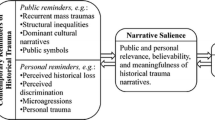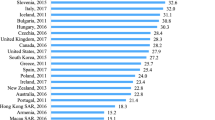Abstract
This study seeks to reground concepts of “diaspora” and “transnationalism” in the realities of everyday life through examining the lived experiences of immigrants. Based on in-depth household interviews and focus groups, it examines the newest Chinese diaspora in Vancouver—skilled immigrants from the People’s Republic of China. It explores the challenges that they face in an unfamiliar city, including employment and language barriers as well as domestic anxieties surrounding childcare, education and marital difficulties. The strategies that they adopt to counter these problems are at times transnational—in the form of astronaut families or transnational childcare—but almost always familial. Ultimately, the settlement challenges that they face, coupled with the available transnational possibilities, raise the question of whether they are settlers or “immigrant prisoners”, temporarily serving their time in Vancouver before a further relocation.
Similar content being viewed by others
Notes
Thereafter, all references to “PRC” or “China” exclude the Special Administrative Region of Hong Kong.
See, for example, Paul Gilroy’s book, The Black Atlantic: Modernity and Double Consciousness (1993).
It was particularly difficult to recruit earlier immigrants who arrived in 1996 or 1997.
Note China’s One-Child policy since 1978.
Two as translators/interpreters and one as a social worker.
This suggests that the PRC immigrants had less precise expectations (Teo 2003b).
Two of the husbands were businessmen who could better afford this arrangement.
According to respondents, the term originated from Hong Kong and Taiwanese immigrants who arrived in the late 1980s and early 1990s with the aim of securing Canadian citizenship as a way to bypass the Hong Kong handover to China and the geopolitical tensions that exist between China and Taiwan. In an ironic turn of events, immigrants from the PRC have now appropriated the discourse.
For the remaining respondents, 11 intended to stay between 1 and 5 years, and three between 6 and 10 years.
References
Alba, R., & Nee, V. (1997). Rethinking assimilation theory for a new era of immigration. International Migration Review, 31(4), 826–874.
Bauder, H. (2002). Brain abuse or the devaluation of immigrant labour in Canada. Paper presented at the Canadian Association of Geographers 2002 Annual Meeting, Toronto.
Citizenship and Immigration Canada. (1999). Facts and figures 1999: Immigration overview [Electronic Version]. Ottawa: Strategic Policy, Planning and Research.
Citizenship and Immigration Canada. (2001). Facts and figures 2001: Immigration overview [Electronic Version]. Ottawa: Strategic Policy, Planning and Research.
Citizenship and Immigration Canada. (2002). Facts and figures 2002: Immigration overview [Electronic Version]. Ottawa: Strategic Policy, Planning and Research.
Citizenship and Immigration Canada. (2004). Facts and figures 2004: Immigration overview: Permanent and temporary residents [Electronic Version]. Ottawa: Research and Evaluation Branch.
Citizenship and Immigration Canada website. (2006). Immigrating to Canada as a skilled worker Retrieved September 28, 2006 from http://www.cic.gc.ca/english/skilled/index.html.
Dirlik, A. (1996). Chinese history and the question of Orientalism. History and Theory, 35(4), 96–118.
Geddie, K. (2002). Licence to labour: Obstacles facing Vancouver’s foreign-trained engineers. RIMM Working Paper #02–21. Retrieved from http://www.riim.metropolis.net.
Gilroy, P. (1993). The black Atlantic: Modernity and double consciousness. London: Verso.
Gordon, M. (1964). Assimilation in American life. New York: Oxford University Press.
Green, A. G., & Green. D. A. (1996). The economic goals of Canada’s immigration policy, past and present. RIMM Working Paper #96–04. Retrieved from http://www.riim.metropolis.net.
hooks, b. (1989). Critical interrogation: Talking race, resisting racism. In J. Clifford, & V. Dhareshwar (Eds.), Traveling theories, traveling theorists, inscriptions, 5, 159–164.
hooks, b. (1990). Yearning: Race, gender, and cultural politics. Boston: South End Press.
Ley, D. (1995). Between Europe and Asia: The case of the missing sequoias. Ecumene, 2(2), 185–210.
Ley, D. (1998). The rhetoric of racism and the politics of explanation in the Vancouver housing market. In E. Laquian, A. Laquian, & T. McGee (Eds.), The silent debate: Asian immigration and racism in Canada (pp. 331–348). Vancouver: Institute of Asian Research.
Ley, D. (1999). Myths and meanings of immigration and the Metropolis. The Canadian Geographer, 43(1), 2–19.
Ley, D. (2003). Seeking Homo Economicus: The Canadian state and the strange story of the business immigration program. Annals of the Association of American Geographers, 93(2), 426–441.
Matas, R. (2002). Chinese immigrants recasting Vancouver. Globe and Mail. 11th December. Retrieved from www.globeandmail.com.
Mitchell, K. (1993). Multiculturalism, or the united colours of capitalism? Antipode, 25(4), 263–294.
Mitchell, K. (1995). Flexible circulation in the Pacific Rim: Capitalisms in cultural context. Economic Geography, 71(4), 364–382.
Mitchell, K. (1997a). Transnational subjects: Constituting the cultural citizen in the era of Pacific Rim capital. In A. Ong, & D. Nonini (Eds.), Ungrounded empires: The cultural politics of modern Chinese transnationalism (pp. 228–256). New York: Routledge.
Mitchell, K. (1997b). Transnational discourse: bringing geography back in. Antipode, 29(2), 101–114.
Ng, W. C. (1999). The Chinese in Vancouver, 1945–80: The pursuit of identity and power. Vancouver: University of British Columbia Press.
Nyíri, P. (2001). Expatriating is patriotic? The discourse on “new migrants” in the People’s Republic of China. In Roy Starrs (Eds.), Asian nationalism in an age of globalization (pp. 144–157). Surrey: Japan Library.
Olds, K. (1998). Globalization and urban change: tales from Vancouver via Hong Kong. Urban Geography, 19(4), 360–385.
Ong, A. (1999). Flexible citizenship: The cultural logics of transnationality. Duke University Press.
Pieke, F. (1998). Introduction. In F. Pieke, & G. Benton (Eds.), The Chinese in Europe (pp. 1–17). New York: St Martin’s Press.
Robbins, B. (1992). Comparative cosmopolitanisms. Social Text, 31/32, 169–186.
Statistics Canada. (2001). Census 2001 Community profile: Vancouver (CMA). Visible Minority Status. Retrieved January 4th, 2007 from http://www12.statcan.ca/english/profil01/CP01/Details/Page.cfm?Lang = E&Geo1 = CMA&Code1 = 933__&Geo2 = PR&Code2 = 59&Data = Count&SearchText = Vancouver&SearchType = Begins&SearchPR = 01&B1 = All&GeoLevel = &GeoCode = 933.
Teo, S.Y. (2003a). Dreaming inside a walled city: Imagination, gender and the roots of immigration. Asian and Pacific Migration Journal, 12(4), 411–438.
Teo, S. Y. (2003b). Imagining Canada: The cultural logics of migration amongst PRC immigrants. RIIM Working Paper #03–16. Retrieved from http://www.riim.metropolis.net.
Wang, G. (1999). A single Chinese diaspora? Some historical reflections. In G. Wang, & A. S. Wah (Eds.), Imagining the Chinese diaspora: Two Australian perspectives (pp. 1–17). Canberra: Centre for the Study of the Chinese Diaspora, Australian National University.
Waters, J. (2003). Flexible citizens? Transnationalism and citizenship amongst economic immigrants in Vancouver. The Canadian Geographer, 47(3), 219–234.
Zong, L. (2003). Language, education, and occupational attainment of foreign-trained Chinese and Polish professional immigrants in Toronto, Canada. In M. W. Charney, B. S. A. Yeoh, & C. K. Tong (Eds.), Chinese migrants abroad: Cultural, educational and social dimensions of the Chinese diaspora (pp. 163–180). Singapore: Singapore University Press and World Scientific Publishing Co. Pte. Ltd.
Acknowledgements
I would like to thank David Ley, Diana Lary, Wei Li, Carlos Teixeira and an anonymous reviewer for their insightful comments on an earlier version of this paper. I am grateful to the Vancouver Metropolis Centre (RIIM) for funding this research and to S.U.C.C.E.S.S.—especially its former Executive Director, the late Lilian To—for help in recruiting some of the contacts. My deepest thanks go to my respondents for their trust in me.
Author information
Authors and Affiliations
Corresponding author
Rights and permissions
About this article
Cite this article
Teo, S.Y. Vancouver’s newest Chinese diaspora: settlers or “immigrant prisoners”?. GeoJournal 68, 211–222 (2007). https://doi.org/10.1007/s10708-007-9071-2
Published:
Issue Date:
DOI: https://doi.org/10.1007/s10708-007-9071-2




